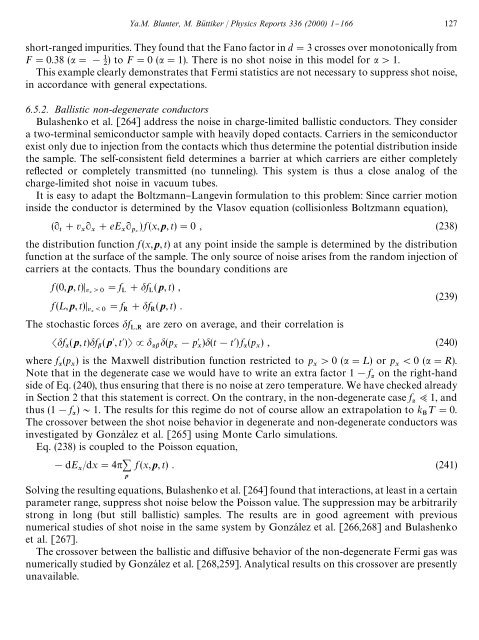shot noise in mesoscopic conductors - Low Temperature Laboratory
shot noise in mesoscopic conductors - Low Temperature Laboratory
shot noise in mesoscopic conductors - Low Temperature Laboratory
Create successful ePaper yourself
Turn your PDF publications into a flip-book with our unique Google optimized e-Paper software.
Ya.M. Blanter, M. Bu( ttiker / Physics Reports 336 (2000) 1}166 127<br />
short-ranged impurities. They found that the Fano factor <strong>in</strong> d"3 crosses over monotonically from<br />
F"0.38 ("! )toF"0 ("1). There is no <strong>shot</strong> <strong>noise</strong> <strong>in</strong> this model for '1.<br />
This example clearly demonstrates that Fermi statistics are not necessary to suppress <strong>shot</strong> <strong>noise</strong>,<br />
<strong>in</strong> accordance with general expectations.<br />
6.5.2. Ballistic non-degenerate <strong>conductors</strong><br />
Bulashenko et al. [264] address the <strong>noise</strong> <strong>in</strong> charge-limited ballistic <strong>conductors</strong>. They consider<br />
a two-term<strong>in</strong>al semiconductor sample with heavily doped contacts. Carriers <strong>in</strong> the semiconductor<br />
exist only due to <strong>in</strong>jection from the contacts which thus determ<strong>in</strong>e the potential distribution <strong>in</strong>side<br />
the sample. The self-consistent "eld determ<strong>in</strong>es a barrier at which carriers are either completely<br />
re#ected or completely transmitted (no tunnel<strong>in</strong>g). This system is thus a close analog of the<br />
charge-limited <strong>shot</strong> <strong>noise</strong> <strong>in</strong> vacuum tubes.<br />
It is easy to adapt the Boltzmann}Langev<strong>in</strong> formulation to this problem: S<strong>in</strong>ce carrier motion<br />
<strong>in</strong>side the conductor is determ<strong>in</strong>ed by the Vlasov equation (collisionless Boltzmann equation),<br />
(R #v R #eE R ) f (x, p, t)"0 , (238)<br />
<br />
the distribution function f (x, p, t) at any po<strong>in</strong>t <strong>in</strong>side the sample is determ<strong>in</strong>ed by the distribution<br />
function at the surface of the sample. The only source of <strong>noise</strong> arises from the random <strong>in</strong>jection of<br />
carriers at the contacts. Thus the boundary conditions are<br />
f (0, p, t) "f #f ( p, t) ,<br />
(239)<br />
f (¸, p, t) "f #f ( p, t) .<br />
<br />
The stochastic forces f are zero on average, and their correlation is<br />
<br />
f ( p, t)f ( p, t)J (p !p )(t!t) f (p ) , (240)<br />
<br />
where f (p ) is the Maxwell distribution function restricted to p '0("¸) orp (0("R).<br />
<br />
Note that <strong>in</strong> the degenerate case we would have to write an extra factor 1!f on the right-hand<br />
<br />
side of Eq. (240), thus ensur<strong>in</strong>g that there is no <strong>noise</strong> at zero temperature. We have checked already<br />
<strong>in</strong> Section 2 that this statement is correct. On the contrary, <strong>in</strong> the non-degenerate case f ;1, and<br />
<br />
thus (1!f )&1. The results for this regime do not of course allow an extrapolation to k ¹"0.<br />
<br />
The crossover between the <strong>shot</strong> <strong>noise</strong> behavior <strong>in</strong> degenerate and non-degenerate <strong>conductors</strong> was<br />
<strong>in</strong>vestigated by Gonzàlez et al. [265] us<strong>in</strong>g Monte Carlo simulations.<br />
Eq. (238) is coupled to the Poisson equation,<br />
!dE /dx"4 f (x, p, t) . (241)<br />
p<br />
Solv<strong>in</strong>g the result<strong>in</strong>g equations, Bulashenko et al. [264] found that <strong>in</strong>teractions, at least <strong>in</strong> a certa<strong>in</strong><br />
parameter range, suppress <strong>shot</strong> <strong>noise</strong> below the Poisson value. The suppression may be arbitrarily<br />
strong <strong>in</strong> long (but still ballistic) samples. The results are <strong>in</strong> good agreement with previous<br />
numerical studies of <strong>shot</strong> <strong>noise</strong> <strong>in</strong> the same system by GonzaH lez et al. [266,268] and Bulashenko<br />
et al. [267].<br />
The crossover between the ballistic and di!usive behavior of the non-degenerate Fermi gas was<br />
numerically studied by GonzaH lez et al. [268,259]. Analytical results on this crossover are presently<br />
unavailable.
















